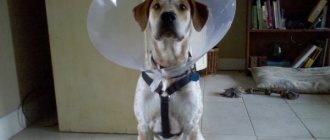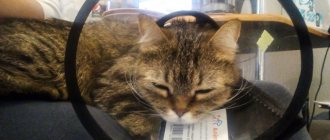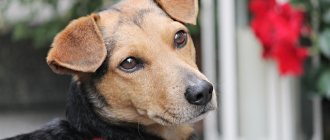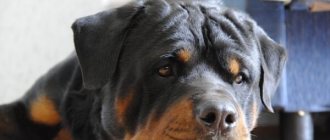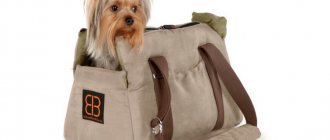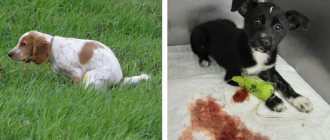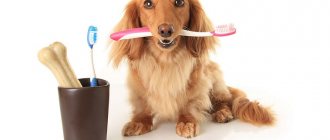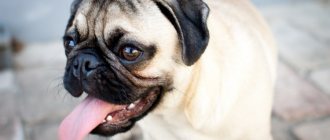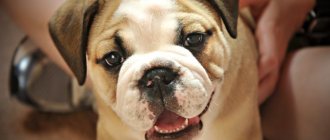Dogs take care of their bodies - combing and licking contaminated areas, licking wounds. This behavior is dictated by instinct and does not create problems when the animal is healthy. But for some diseases, it is undesirable to scratch and pour out the affected areas. It is impossible to explain this even to smart and obedient pets. It is also difficult to control them around the clock for several days or weeks, each time stopping unwanted actions. It is more convenient to put a collar on a dog - a simple protective structure in the form of a funnel, which is attached to the neck and prevents licking the paws and body, or scratching the head. Such a collar is inexpensive, does not cause much discomfort to the dog, and with the right approach it is not difficult to dress, especially if you have experience wearing overalls for a walk. You can buy it in veterinary pharmacies and pet stores.
What is needed to make a collar
You can make a cone for a dog’s neck yourself using available materials:
- thick cardboard;
- plastic bottles;
- foam;
- felt.
You will also need scissors, tape or adhesive tape, shoelaces, and possibly a stapler.
The main thing is to take the correct measurements so that your pet is comfortable. To do this you need to find a centimeter.
Note! Some people use a plastic bucket to create a post-op collar, making a hole in the bottom for the head. But such an invention is inconvenient for the animal, especially if it is much longer than the muzzle. In addition, the bucket will make noise, scaring the dog.
Making a protective product for a pet
You can make a collar for your pet yourself. There are several different ways to make it, depending on the materials chosen.
Express version made from cardboard
If you don’t have time to purchase a collar, but you need it urgently, you can build it in a short time from what you have at hand. You will need:
- thick cardboard;
- tape measure;
- compass;
- stapler;
- scissors;
- scotch.
The procedure is as follows:
- On a sheet of cardboard we draw a semicircle (diameter - 20–25 centimeters).
- Cut out the part and roll it into a funnel.
- Using a measuring tape, we find out the circumference of the pet’s neck.
- At the base of the cone we make a hole, the diameter of which is equal to the circumference of the cat’s neck.
- After you wrap the future collar around the cat’s neck, its side sections will need to be secured with a stapler or tape.
Video: making an “Elizabethan” collar with your own hands from cardboard
Collar made of plastic
To make a plastic collar you will need:
- two-liter plastic bottle or stationery folder;
- Velcro;
- stapler;
- scissors;
- adhesive plaster.
A plastic collar is not the most comfortable option available. But if the animal does not have too long a rehabilitation period, then it is quite suitable, especially since this product can be made more comfortable.
Do not give in to provocation - any animal will try to remove the collar
It is made as follows:
Cut a two-liter bottle in half (or unfold a plastic folder), draw and cut out a collar in the form of a semicircle (it is also better to limit its diameter to 25 centimeters). Fold the semicircle into a cone. At its base, cut a hole with a diameter determined by the thickness of the cat’s neck. Attach Velcro fasteners to the side sections of the cone with a stapler. You can also make holes at the edges of the cuts using sharp scissors and connect them with a soft cord or ribbon. Cover the top and bottom edges of the collar with adhesive tape. This will soften the edge adjacent to the cat's neck and strengthen the one that will encounter obstacles
It is very important that all edges of the homemade plastic collar are even and smooth.
Sleep
The Butter Collar is designed for sleeping, although some dogs will be uncomfortable at first and may take some time to settle in. They won't be able to tuck their head into their paws the way many dogs do when they sleep, and to make your dog feel secure, make sure their bed is comfortable and warm, and on the wall, consider a pillow or ledge for yours. dogs too, if it is more convenient for them to lay their head down.
Every pet needs veterinary care. However, it is not always easy for an animal to allow certain manipulations to be performed on itself. In addition, after surgery or injury, you should not allow your four-legged friend to lick or scratch wounds. To prevent the dog from self-injuring, barrier (restrictive) therapy is used. One of them is a standing protective collar. It is also called post-operative or Elizabethan. This device is shaped like a truncated cone, the narrow part of which is placed on the dog’s neck. It prevents the animal from reaching the wound on the head with its paw, and the tongue from reaching the damaged area of the body.
How long should a cat wear a collar?
Castration of cats is considered a simple operation. However, as after any other surgical intervention, the pet requires careful and proper care. The postoperative wound is small, and the sutures are predominantly self-absorbing. Waking up after anesthesia, the cat will try to lick the wound. If you give him this opportunity, it will take a long time to heal. In addition, infection may occur. Based on this, veterinarians insist that the cat needs to wear a medical collar for the entire rehabilitation period. This process can last 7-14 days. The duration of wearing depends on the individual characteristics of the pet’s body, its age and state of health. They put the collar on the pet while he is still under anesthesia.
The more attentive the owner is to the cat, the faster the seam will heal and the need to wear a protective device will disappear.
Indications for ear cropping in dogs
Animal lovers these days are increasingly raising their voices in defense of their rights, so ear cropping operations for dogs, that is, surgical shortening of the ears, are considered by many to be violence against living beings.
However, opinions are expressed that in a number of cases, such a measure is caused by objective necessity. Is this really so, or maybe gross interference in Mother Nature’s livelihood is just a whim of animal owners and a tribute to outdated wild customs and prejudices?
Let's look at the situation from different angles. Ear cropping : what are the reasons for carrying out such an operation? The breed standard is the first and, perhaps, the main one.
As a rule, similar requirements are imposed on fighting and hunting dogs. During an unpredictable fight with a wild and agile animal or rival relatives, long ears are easier to damage, which affects the outcome of the fight.
In addition, some owners believe that docking gives their pets a more menacing appearance. A striking example of this is the cane ; ear cropping in this breed is done in the shape of a regular triangle, which gives the appearance clear contours, making it more masculine. Although, according to accepted rules, the Cane Corso has drooping ears.
Types of collars for dogs
Dog neck cones are made from different materials. Each of them has its own advantages and disadvantages.
Fabric
The fabric construction is hypoallergenic, waterproof and reusable. Among the disadvantages are a poor viewing angle and low strength. The accessory wrinkles easily, so if the dog really wants to, he can quickly get rid of it.
Plastic
A product made of transparent plastic is a classic option with a minimal price. Its main problems are its short service life and loud noise when in contact with other surfaces.
Inflatable
It differs not in material, but in shape. Resembles a life preserver, providing a very good viewing angle. Suitable for animals with short legs and neck.
DIY dog collar
For small breed dogs, the collar can be based on an x-ray, and for larger breeds, it can be a plastic dishcloth, thick cardboard or corrugated cardboard. The workpiece is given the shape of a cone, and the edges of the lower and upper diameters should be wrapped in soft cloth (gauze), secured with tape, or covered with adhesive tape to avoid injury to the animal’s neck.
The bottom circle should be equal to the diameter of the fastened collar. The width of the collar is the length from the neck (where the collar is) to the tip of the nose and an additional 5 cm.
Some dog owners simply wrap a towel around their dog's neck, securing the edges with a bandage or tape to prevent the towel from falling apart. The towel acts as a neck brace, preventing the neck from turning.
Why do dogs wear a cone?
Why or why do dogs and cats wear a cone around their neck?
A cone or protective collar is indeed sometimes placed on dogs. But this is a forced and temporary measure that is necessary for dogs, or rather for their protection. Such a collar is usually made of flexible plastic (branded) or cardboard (homemade). It does not particularly restrict the dog’s movements, but still prevents it from performing certain actions. When is it indicated for dogs?
Not all dogs like this “decoration”; some begin to actively resist, so you need to gradually accustom the dog to the collar. It is usually removed when eating. I made such a collar for my cats with ear mites, lichen lesions, and after operations. In principle, animals get used to it quite quickly and can wear it, if necessary, for quite a long time.
Typically a medicated collar is placed on dogs or cats to prevent licking. For example, after castration or other surgery. By licking the animal, it irritates the sore spot, it becomes infected with pathogenic bacteria and fungi, and eczema can develop. Such a collar deprives our pets of peripheral vision and they will bump into furniture and doors, so in such cases it is better to wear it when the animal is left alone at home. I believe that you should not wear such a collar on walks - the dog is already under supervision on a leash. When I treat a dog’s ears or eyes, there is no need to wear such a collar. After treatment, the dog feels better and does not scratch with its paws. Although everything is very individual.
Good day! Most often this happens due to some kind of disease in the dog; the cone is put on them so that the dog cannot hurt itself and make the disease much more severe. But the dog will still be mentally traumatized when wearing a cone and will be limited in its actions.
The animals are given a cone to prevent them from scratching their wounds. My pit bull terrier's ears hurt, or rather not inside, but some kind of infection that caused sores. Therefore, in addition to medications, it was recommended to wear a cone to prevent it from scratching the wounds.
The cone, or protective collar, is put on dogs for a reason; it is a forced (temporary) measure necessary for the dogs and their protection. The collar is made of flexible plastic (branded) or you can make it yourself from cardboard (homemade).
Dogs are given a cone to prevent them from itching, chewing their paws, or licking their paws.
A dog does not always enjoy medical care or grooming procedures. It also happens that after surgery or injuries, you should not allow the animal to lick, scratch or comb the wounds. In order not to sit over the dog and prevent it from scratching where it wants, it is better to use a protective collar. It is also called postoperative.
This device is a truncated cone, which with a narrow diameter is attached to the dog’s neck. It prevents him from scratching a wound on the head with his paw (for example, cropped ears) or licking a wound on the body.
When is a dog collar used?
They are used quite widely:
Processing the seam
After sterilization, the suture is located on the dog’s underside, along the so-called white line - from the navel to the tail. The length of the suture depends on the size of the dog and can be from 2 to 10-15 cm. Doctors recommend removing the sutures 10-14 days after the operation. In some cases, removal is carried out earlier (if healing is good or, conversely, if the suture material is rejected). The seams are treated daily 1-2 times a day.
As a rule, seam treatment does not cause any discomfort to dogs. On the contrary, some pets enjoy having their belly scratched, especially after a few days when the stitch may itch a little as it heals. Cats, for example, endure this procedure much more painfully, because... their groin area is “inviolable” for strangers.
Immediately after the sterilization operation, the dog is put on a special blanket so that it cannot lick its stitches. You should immediately purchase a second blanket to replace it, because... In the first days after sterilization, there may be slight bleeding from the suture. In addition, the blanket will become dirty during the walk.
It is most convenient to treat the seam with sterile gauze wipes. Ready-made napkins are sold in packs of 10 pieces at the pharmacy (price 10-15 rubles). You can use a sterile bandage and simply fold the piece into several layers.
The napkin is generously moistened with a solution of hydrogen peroxide and applied along the entire length of the seam. It is preferable to use peroxide because... it will well soak up the bloody crusts, which must be removed. Use a second napkin along the seam to remove all dirt so that the seam is clean. Then blot dry.
After general wound hygiene, the suture is treated with any wound-healing and anti-inflammatory agent (see section Drug postoperative support).
The seam can then be treated with the following means (optional):
| The ointment is applied to the cleaned seam 1-2 times daily. A sterile gauze pad is applied to the seam on top and a blanket is put on top. A 40 g tube of ointment costs 110 rubles. |
| This is a veterinary drug. You can treat the seam with it once every 3 days. This may be beneficial for owners of aggressive dogs, or for dogs kept in kennels and kennels. The cost of the aerosol is 520 rubles. |
Aluminum sprayAfter application to the seam, a thin film is formed that prevents the penetration of bacteria and contamination of the wound. Treatment can be carried out daily. The price is about 800 rubles. An analogue could be the “Second Skin” spray, its cost is 380 rubles. |
Terms of use
In order for a post-op dog collar to perform its task as effectively as possible, it must be used correctly. The main problem that owners face is the dog’s reluctance to wear a collar, since the thing is new and uncomfortable. At the first attempt to put a barrier on a pet, the owner encounters active resistance from the dog (the animal may growl or bite the hand). Even if you managed to fix the collar, the dog will certainly try to remove it and will become nervous and angry.
To speed up and facilitate the adaptation process, you need to prepare the dog in advance. This option is suitable for those cases when you do not urgently need to put on a collar. For example, before surgery.
- The pet needs to be shown the item and allowed to sniff it.
- Prepare the item for use (assemble, inflate, test fastenings, etc.) and demonstrate it to the dog again.
- Try on the product and make sure that the parameters are selected correctly - the collar does not press, does not fall off, or rubs the skin.
- Distract your pet with play, attention or food. Under no circumstances should you leave an animal unattended for a long time.
- The barrier should be periodically removed and put on again, each time extending the period of wear.
- When the funnel is removed, you must carefully monitor the dog's behavior and do not allow it to lick or scratch the wound.
The collar is secured on the neck with Velcro or special strips that are attached to the collar.
Postoperative period
After castration, which is carried out under anesthesia, in about 20-30 minutes you can take the cat home from the veterinary clinic. It is best to place the operated cat on a soft, clean bedding on the floor, since coordination of movements is impaired for several hours after anesthesia. In addition, the cat is very weak and may experience severe discomfort. Some pets show anxiety and cannot find a place for themselves, while others, on the contrary, recover from anesthesia and constantly sleep.
This condition can last from 24 to 48 hours. It all depends on the weight, age of the cat, general condition, individual parameters, the state of the nervous system, as well as on the dose of anesthesia used for anesthesia of the drug.
Caring for a neutered cat involves creating the most favorable, calm environment possible. During this period, the pet needs increased attention and care, since any surgical procedures are stressful for the cat.
Despite the fact that postoperative wounds are small and heal quite quickly, in order to avoid possible complications, it is necessary to closely monitor your pet.
Your veterinarian will tell you how to properly care for your cat after surgery, what to use to treat wounds, and when you need to bring the cat to have stitches removed, unless, of course, you used self-absorbable surgical material.
To ensure that the rehabilitation period passes quickly and without any complications, follow all the recommendations of the veterinary surgeon.
In the first two or three days, make sure that the cat does not rub its back on the floor or try to remove the stitches. But since it is not always possible to monitor the cat around the clock, we recommend wearing a special protective collar. Only take it off when feeding.
When and why does a cat need a collar?
A protective collar is a veterinary device in the shape of a horn or funnel that limits the animal's mobility. As a means of protective therapy, the collar will prevent the cat from licking medications from the body, licking a post-operative suture or a damaged area of skin.
The veterinary collar is also called the “Elizabethan” collar. This is due to the fact that it resembles a piece of clothing worn by noble ladies of the era of Queen Elizabeth I of England. In the 16th century, lush, rigid collars made of starched fabric (usually lace) were in fashion. Of course, turning your head in such a dress was extremely difficult. Later, this design served as the basis for the creation of a veterinary collar.
The veterinary device resembles the collar of Elizabeth I's royal dress
Barrier therapy, of which the collar is one component, is used for a number of health problems in pets. Here are the main ones:
- The cat tries to lick the wound (especially if it heals and begins to itch), this prevents the restoration of the damaged area of skin.
- The animal has undergone medical surgery (for example, a spay procedure or tumor removal). In such a situation, it is important to prevent licking and chewing of the sutures placed by the veterinarian.
- The cat has been neutered. In this case, the animal will not have stitches, but the operation site is treated with an antiseptic, which also cannot be licked off. There is also a danger that the cat will begin to lick the sore spot and thereby provoke bleeding.
- Your pet's ears hurt. The animal begins to scratch them, which provokes additional infection, as well as untimely removal of veterinary drugs from the ear cavity.
- The cat was treated with a remedy against ecto- and endoparasites. Animals should not lick such substances, as this can cause poisoning. And you won’t have to wait for the effect of the antiparasitic agent either.
- A cat that is active, fearful or aggressive needs to have its fur or nails trimmed. The collar will protect the owner from pet bites.
The protective collar is shaped like a bullhorn
In all of the above cases (except, perhaps, for ear diseases and treatment for parasites), the owner of the animal is faced with a choice: a special blanket or a veterinary collar.
The blanket will protect the postoperative suture from not only germs, dirt and fungi getting there, but also from the cat itself, which after surgery tries to chew or lick the place that bothers it
The advantages of the blanket are that it:
- does not restrict the cat's movements;
- does not cause her anxiety or irritation;
- allows you to wash exposed areas of the body;
- protects stitches or wounds from contact with other objects that are not always safe and sterile.
But especially active pets manage to take off their blankets. And if they leave them alone, they begin to lick the sore spot through the fabric. Sometimes even this is enough to damage the seam. Blankets also get dirty quickly, especially if the wound needs to be treated with medications.
Advantages of a collar compared to a blanket:
- completely limits the cat’s access to the sore spot, be it the head, paws or torso;
- the animal will not be able to hide in a hard-to-reach or inappropriate place thanks to the voluminous collar on the neck.
The pet will be dissatisfied with the presence of the collar, since it can hardly be called comfortable. The cat will cling to surrounding objects with it and try to remove it. And most importantly, the collar needs to be chosen correctly.
Some owners purchase both barrier products for their pet to be on the safe side.
Using a blanket and collar at the same time completely protects the wound or seam from access by the animal
Veterinary pharmacies and pet stores offer a large selection of Elizabethan collars for cats. Their cost depends on the materials and the size of the pet for which the device is purchased (they are not divided into cat and dog). The price of such products ranges from 100 to 1200 rubles.
Preparing for work
Before you begin, you should decide on the purpose of the pet costume, the frequency of its use and design. Any homemade clothing for cats must include:
comfort: when worn, the pet is comfortable in the outfit, its movements are not constrained; quality: when making clothes for a cat with your own hands, you need to pay attention to non-artificial materials. Only inserts or trim made of synthetics are allowed
The reverse side of clothing for cats should be completely natural to avoid allergic reactions; simplicity: simple cut of clothes ─ a minimum of seams and costume items; practicality: clothes for frequent wear should not lose their appearance after cleaning and washing.
Material selection
You need to decide whether the cat's clothing will be sewn or knitted. In the first case, fabrics, accessories, and finishing are selected. In the second ─ suitable yarn.
Choosing the material for your pet's clothing is the most important part of the work. If the cat doesn’t like it, all efforts will be in vain. It is difficult to force your pet to wear such clothes.
In order not to make a mistake with the choice, you can first put the selected material or yarn on the cat’s bed. The fabric must first be washed with a neutral detergent. If the surprise on the bedding does not cause protest from the pet, then you can safely start creating patterns, sewing or knitting.
It is better to choose soft, flexible fabrics for cats: knitwear, cotton or linen with a stretch effect. Clothes made from this material are comfortable and will not hinder your pet’s movements. The appearance of things will not suffer from frequent washing.
The finished knitted product must be washed.
Taking measurements
Creating clothes for a pet with your own hands begins with creating a pattern, for which you need to take measurements
It is important to determine the size correctly. The fit of the product on the cat and its comfort depend on this.
To take measurements from the model, you need to take a centimeter tape. To create a universal pattern, it is enough to determine 3 main parameters of the pet:
- ОШ – neck circumference. Measured at the base of the neck - where it meets the chest;
- OG - chest circumference. Calculate along the widest part of the cat’s body, under the front legs;
- DI is the length of the product. Equal to the distance from the base of the neck to the base of the tail.
Based on these measurements, you can design any styles of clothing for various purposes for your cat.
If the product involves sleeves and a collar, then the following measurements are also needed for the pattern:
- OT - body circumference. Measured across the stomach, in front of the hind legs;
- OPL and OPL are the girth of the front and hind legs, respectively. Calculated based on their widest part;
- LSH - neck length from base to ears;
- DT - length of the body between the front and hind legs.
When creating a drawing, length measurements are taken in full, and the length of the girths is divided in half. Armed with the numbers, you can safely start cutting out a costume for your pet.
Universal drawing
The figure shows an approximate drawing from which you can create various clothing patterns for cats.
The top image is the back, consisting of two parts. The lower part is the tummy. Half of the part is drawn, a fold runs along the middle line. Semicircular recesses are holes for the pet's paws (armholes).
The DI measurement is laid along the lightning line. Next, a drawing is built from it in accordance with the size of the cat. Line CD is the length along the tummy from the front to the back paw.
When cutting the product, remember that clothing for cats should not be too tight. To do this, add 1-3 cm to the pet's girth measurements for a loose fit.
Seam allowances must be made along the contour of the pattern. Their size is adjusted as follows: add 0.5-1 cm along oblique and figured cuts, and 1-2.5 cm along side and shoulder seams. Clothes for a cat should not be too loose.
Required Items
To create clothes for cats with your own hands, you need to prepare a workspace: a table or any flat surface for cutting.
You will also need:
- paper or fabric for making a pattern;
- yarn and knitting needles or crochet hook if the project involves a knitted item;
- fabric: main, lining, cushioning (insulation);
- tailor's chalk;
- adhesive materials for strengthening oblique and figured cuts;
- sewing accessories: buttons, snaps, zippers, Velcro fasteners;
- finishing accessories: braid, lace, adhesive applications;
- sewing threads;
- needle;
- scissors;
- sewing machine.
Now you can start creating an original, stylish set of clothes for your pet.
Julia
Zhulya The time has come for her to give birth, she suffered all night, but never gave birth.
In those distant times, private clinics were just emerging, so we urgently learned the doctor’s address and rushed to save the life of my favorite. Just as women undergo caesarean sections, they cut my Zhulya. The doctor warned that the operation itself was not complicated; the postoperative period was dangerous, when the dog, while licking the wound, could bite the threads and the stitches would come apart. You can’t tell her that she can’t do this. After the operation, I “wrapped” my dog in a blanket: I took a piece of fabric, cut out 4 holes for the legs, and laced the back. While my Zhulya was recovering from anesthesia, everything was quiet and calm, she lay in her crib, snoring through her nose.
But then she began to get up, and imagine my surprise when I saw my Julia without this blanket. How she managed to free herself, I have no idea.
How to put a collar on a dog
After purchase, you can begin direct use. Correct donning will make subsequent use easier and will have a beneficial effect on the final result.
Sequencing
After the operation, the animal is dressed by the veterinarian, and in all other cases by the owner himself. To do this, just follow the following algorithm:
- Prepare the product and secure the pet in place - alone or with an assistant.
- Place the cone around your neck and secure with clasps.
- Check the seal with your finger. It should fit freely between the neck and the accessory.
- Praise your pet and treat him to a treat.
If the situation does not require urgent use, take care of training. This will make subsequent wearing easier.
How to accustom an animal to a cone
Show your pet an unfamiliar object and let him sniff it. Once you are sure there is no fear, put it on and distract your dog with food or play. Take the product off and on until the dog gets used to it. Usually the adaptation period takes 2-3 days.
What to do if the dog takes off the cone?
If adaptation is delayed, then there is a high probability that an error was made with the size or material. Try choosing a model with a tighter fit - or replace noisy plastic with fabric.
Collar for animals after surgery
If the dog has undergone surgery and has stitches on its body, a veterinary collar must be worn until they are completely healed. Both a large dog and a small dog need such protection. The owner must immediately prepare a cone for the animal's neck. It is better to wear it while the pet is under anesthesia after surgery.
Doctors will tell you how to choose cones depending on the type of operation. During this period, you need a tall plastic cone that will prevent you from scratching the sore spots with your paws. For abdominal operations, you can choose a soft or inflatable collar. It is more difficult to choose the right funnel if a cast or bandage is applied to the paws. Owners prefer to wear soft structures that limit the mobility of the cervical spine.
Product options and their features
Collars for dogs differ according to the following criteria:
- Purchased at a pharmacy or veterinary clinic, or made independently (from fabric, plastic, for example, from a bucket or bottle).
- Material of manufacture, shape and other features.
The following options for protective collars are available:
- Elizabethan (classical);
- plastic tube (closes into a circle, and a removable cover is put on top of it, which does not allow the neck to move freely, fixing it securely);
- soft collars;
- inflatable;
- elastic neck corsets (made of soft foam, secured to the neck with Velcro, limiting its mobility) - recommended for protecting problem areas on the body, not on the head.
Elizabethan collar
Soft
The design is made of waterproof hypoallergenic material.
Product advantages:
- flexibility;
- ease;
- safety;
- strength;
- Suitable for reusable use (the item can be neatly folded and stored).
Flaws:
- the device is not suitable for large dogs, since the animal can reach the collar and crush the pliable material;
- if the dog has a long neck, this design will not protect the head well enough;
- lack of free view.
Another type of soft postoperative collar is a cone-shaped design made of waterproof nylon and equipped with a plastic insert at the bottom.
The latter gives additional rigidity to the device. As a result, the pet cannot bend the barrier. The collar is fixed with Velcro. On a note! The advantage of soft products is the most comfortable use: the animal can eat and sleep in it without any problems. This collar does not make sharp sounds when in contact with the environment. The fabric base ensures normal air exchange and thermoregulation. Soft collar for dogs
Inflatable
This type of collar includes many variations, which differ in the type of material from which they are made. A common feature of all such structures is a shape reminiscent of a lifebuoy. The item is made of a soft and flexible material that can be transparent or include a nylon cover.
Advantages:
- comfortable use;
- free review;
- good fixation;
- easy transportation.
Flaws:
- rapid wear (dogs can easily tear the material with their claws when trying to reach the problem area) when used without a cover;
- not suitable for dogs with long limbs.
Inflatable collar
Plastic
This is a classic Elizabethan collar. The shape of the structure is a truncated cone. Material: transparent, translucent or colored plastic.
Advantages:
- transparency of the material (in most cases);
- flexibility;
- ease of care of the device (very easy to clean);
- low cost;
- availability (sold in every pet store).
Disadvantages of the product:
- noise when in contact with surrounding objects (the sounds are sharp and loud, which makes the dog scared);
- short service life (such a collar quickly becomes unusable because the plastic cracks and breaks).
Manufacturing instructions
DIY cat collar
For most materials, the manufacturing instructions are absolutely identical:
- Measure the circumference of your pet's neck.
- Draw a circle of the appropriate diameter, its radius should be an order of magnitude larger than the actual size of the neck. This is necessary so that it is not difficult to put the resulting product on the dog.
- The next step is drawing the outer circle. The distance between the two circles should be 5 cm less than the length of the pet's muzzle. It is these indicators that will allow you to make the “right” accessory that will not cause the dog any discomfort.
- Cut out the outer and inner circle. For convenience, it is best to make a cut in the center.
- After fastening the sides of the collar with tape or a stapler, you should end up with a cone with the top cut off.
- Then you need to put the collar on the old collar and secure the resulting product to it.
Advice! To draw a circle you need to use a compass; it will allow you to create the most correct and accurate product.
From a plastic bottle
You can make a collar from an ordinary plastic bottle according to the example described above for a small dog. If a large dog needs this accessory, you can use a 5-liter bottle.
From cardboard
Cardboard is a very convenient material for crafts, but it has a number of shortcomings and quickly becomes unusable. It can tear and get wet.
From fabric
Fabric products are very comfortable for the dog, but they are a little more difficult to make. First you need to make the base, and only then sheathe it or cover it with fabric.
Fabric collars are more often used in the form of corsets that protect not only the neck, but also the upper part of the animal’s body. They are equipped with a whole set of Velcro and even a special attachment for a leash.
A fabric corset is usually required in cases of serious injury
From foam rubber
Foam rubber is a very soft material; just like fabric, it requires the manufacture of a frame. What it will be made of is decided by the dog breeder himself. It can be plastic or the same cardboard.
More often, polymer foam, rather than foam rubber, is used to make a collar. This corset is as elastic as possible and only limits the mobility of the dog’s neck.
The product is made of polymer foam and is very comfortable for the dog.
Inflatable
It is very difficult to make an inflatable collar yourself. But you can buy such a product in specialized pet stores.
It is convenient, absolutely non-hazardous and, most importantly, hygienic. This type of protection is the most popular among experienced dog breeders.
The soft and absolutely hygienic material does not cause any inconvenience to the pet and does not interfere with eating or sleeping.
On a note! There are several models of inflatable collars on the market, some even equipped with a special rigid insert.
The inflatable product has an external resemblance to an inflatable ring
Knitted
A knitted product can be made independently, but to do this you need to know how to knit. Similar accessories are also sold in dog stores. They have more of a decorative function than a protective one.
Protective collar for dogs
Dogs, like people, also get sick, but unlike people, animals do not understand that they should not disturb a wound, comb problem areas of the skin, or lick postoperative stitches. Therefore, to speed up the healing process of damaged areas of the body and prevent infection, animal owners have to resort to using a special protective collar for dogs.
Barrier therapy is also used in other cases, for example, during the period of action of an external drug against parasitic insects in order to prevent the possibility of an animal licking the product applied to the fur and skin, which can lead to poisoning.
A protective collar may be needed for the period of treatment of eye and ear diseases, skin diseases, as well as for the period of healing of cropped ears, burn wounds, during the period of false whelping, so that the bitch does not lick the nipples and does not stimulate the mammary glands, which leads to increased production milk, but this cannot be allowed.
Size selection
The sizes of protective collars vary significantly. The need to wear a funnel occurs in dogs of various breeds. Their body size and structure are different. It is important to choose the right protective structure. The size of the product is selected according to the circumference of the neck. It is easy to measure it at home with a centimeter, and at a veterinary pharmacy or pet store the seller will select a comfortable collar of the right size.
For breeds with long, mobile necks (collies, German shepherds, Dalmatians, Great Danes, spaniels, pinschers), choose tall cones that completely cover the nose. For bulldogs, boxers, pugs, St. Bernards and other short-necked breeds, it is more convenient to use low funnels that minimally restrict movement.
The choice of cone height also depends on the location of the problem area on the pet’s body. The low design, which limits the mobility of the neck, will not interfere with scratching the ears and eyes, but will not allow licking the back.
How to properly put protection on your pet?
It is important to understand that the size of the product is critical. For the veterinary protection functions to work and not cause discomfort, the collar must fit well on the animal
If you go to the store to buy a finished product, measure the circumference of the dog’s neck. The seller will select the necessary option with knowledge of the matter.
All veterinary collars are secured around the dog's neck. For this, a collar, cord, bandage, tape of fabric and other convenient materials are used. The device is designed to limit unwanted actions and becomes a barrier between the head and torso.
Getting used to wearing a collar correctly
We have sorted out the material of the model and the size, all that remains is to convince the dog that the structure is attached for its own good and there is no need to be afraid of it or try to remove it. It will take a little patience:
If the animal is awaiting a planned operation, purchase or make a barrier collar yourself a few days before the event. Leave the protective device within the dog's reach
Let him sniff, examine an unfamiliar object, get used to it. First, in the disassembled version, then assemble it. When the pet calms down and stops paying attention to the object, carefully, slowly, put it on the dog. Distract the animal with play if the disease does not prevent activity. Show that the product does not bother him Talk to him in a calming, gentle way
If there are no attempts to get rid of the collar, reward him with your favorite treat. For the first fitting, 2-3 minutes is enough. In subsequent times, increase the time by a few minutes. As soon as the dog comes to terms with the foreign body on its neck, teach it to eat and walk in it. If no problems arise, leave the device to sleep. It happens that a protective device has to be used after an accidental injury or urgent surgery, when there is no time for psychological preparation. If the collar bothers your pet unnecessarily, remove it for a while and carefully monitor your dog's actions so that he does not harm himself. When the anxiety subsides, put the protection back on. Complete adaptation usually takes place within two days.
This useful and easy-to-make device will protect your pet from unwanted damage when scratching and licking. Follow the recommendations of specialists and carefully study the instructions for the product. The recovery process will be faster and more painless in this case.
Everyone knows that dogs are very smart animals. However, like any other animal, it is difficult for them to immediately understand when something suddenly cannot be done that they have always done. For example, scratching an itchy area or licking a wounded place on the body.
Photo: Todd Dwyer
In this situation, you have two options. You can try to constantly monitor your pet and not allow him to scratch his sore ear or lick the surgical suture. In the second case, you just need to put a protective collar on it.
Don't keep your dog on a chain! Why is this dangerous, and what is the best way to keep a dog in a private home.
Is it normal to have a dog on a chain? Let's think... There are quite a lot of people who live in private houses and get dogs. Someone for security, someone as a call, someone just as a friend. And if everything is clear with dog friends, they usually only theoretically live on the street, but in fact sleep with their owners in the same bed. With dogs that are taken into custody, a story like “ whole life is on a chain”
How dangerous is such an existence for a dog:
1) Restriction of movement. Even a long chain significantly limits the dog’s movement, and as a result, leads to health problems
. Most often, the musculoskeletal system of a dog, especially a puppy, is affected.
2) High probability of accidents
. For example, a dog can get caught on something and hang on a chain, or, to be more precise, hang itself... The dog can get entangled in it and get injured...
3) A dog on a chain is defenseless
Many people don’t even think that a dog on a chain is the most vulnerable guard
. If thieves break into the territory of a private home, then it is the chained dog that is easiest to neutralize. You can be at such a distance from her that she cannot reach the attacker, who, in turn, can calmly at this time, using a stick, a sharp object, a stun gun, (and many others) neutralize (perhaps even forever) the dog . A dog that is freely guarding the territory poses a much greater danger to thieves. She can run away from them, attack unexpectedly, run around, etc. Moreover, NOT
a chain dog, as a rule, knows the boundaries of its possessions much better, and senses that someone else wants to cross them.
Also, the dog is on a chain, defenseless, if suddenly, God forbid, a fire
. Are there many such cases when chained dogs died in such situations? I don’t blame anyone, people sometimes don’t even have time to save their loved ones...
A dog on a chain is defenseless in case of adverse weather conditions
, for example, if she gets caught on something and cannot hide in the booth during the rain.
A dog on a chain is defenseless if predators such as wolves
. And this is far from a rare occurrence in our time; if a wolf looks into the territory of a house, then a chained dog has no chance.
4) Chain dogs often “degrade”
. Maybe it's a harsh word. But is there really a very noticeable difference between the behavior of a chained dog and a dog living in “free flight”?
Of course, what I wrote is very general and there are exceptions to the rules. But still, if you, think about the fact that it is also a living organism
The ideal content for a guard dog is to freely guard your yard. When a dog simply has its own kennel, and it moves freely in its territory. Of course, in this case, you need to create conditions such as a good fence (about 2 meters high), the impossibility of digging for the dog (concrete base of the fence), a place where you can temporarily isolate the dog (an enclosure).
I will make a separate article about what a proper booth and enclosure should look like, although there is already quite a lot of this information on the Internet.
If, after all, only keeping your dog chained is suitable for you, try to follow the following rules:
1) Walk the dog, let it off the chain, take it out of the yard, give it the opportunity to run, jump, lie in the grass,... Give it time.
2) Make sure that in the area where the dog moves, it will not cling to objects with a chain anywhere, and will be able to freely enter the kennel at any time.
3) Place a bowl of water where she can easily reach it.
4) The dog should not be able to jump over the fence and hang on it. Sometimes owners, without hesitation, place a booth near the fence. And the booth is a good “springboard” for a jump, perhaps the last one...
Perhaps with this article I will run into a lot of negative comments from people who believe that a dog does not need so much attention and understanding, but still, I always ask everyone to think that it is not the dog that turns us on. We are getting a dog, and therefore we are obliged to make it comfortable.
